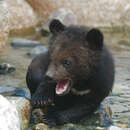en
names in breadcrumbs


Theria is the lineage of mammals that give birth to live young. This includes the marsupials (Metatheria) and placental mammals (Eutheria), but not the egg-laying monotremes (echidnas and platypus are the only surviving monotremes).In addition to reproductive strategy and adaptations, more technical characters that define the Theria include (Killian et al. 2001):
•Olfactory bulb cell organization
•Braincase architecture
•Mammary glands with teats
•Cranial nerve distribution
•Tooth enamel
•Molar dentition: tribosphenic molars
•Inner ear architecture
•Ankle anatomy (crurotarsal ankle joint)
•pectoral girdle morphology
The traditional, and once again prevailing view of mammalian evolution is the therian hypothesis: that the monotreme lineage and therian lineage diverged from one another in the Triassic period (about 200 million years ago) from ancestors in different geographical areas, with the monotremes endemic to Gondwanaland and the therian mammals arising in Laurasia.Therian mammals are thought to have originated 170-150 million years ago (Hugall et al. 2007; Killian et al. 2001; Luo et al. 2001). For a time, morphological (especially dental) analysis of fossils and early molecular work disputed a sister relationship between marsupials and placental mammals, positing an alternative theory of relationship between the three mammals lineages (the marsupionta hypothesis): that monotremes are specialized members of the marsupial mammals (Gregory 1947; Janke et al. 1987; Kirsch and Mayer 1988).